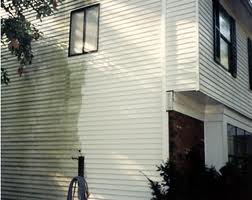
Get A Jump On Spring Mold!
 Spring comes early in North Carolina. Heralded by terrific moisture-laden thunderstorms, heat and humidity soon arrive and combine to support the perfect breeding environment for a very unwelcome southern springtime guest: mold. Gray-green mold colonies are commonly found growing on the siding of North Carolina homes during the warm-weather months.
Spring comes early in North Carolina. Heralded by terrific moisture-laden thunderstorms, heat and humidity soon arrive and combine to support the perfect breeding environment for a very unwelcome southern springtime guest: mold. Gray-green mold colonies are commonly found growing on the siding of North Carolina homes during the warm-weather months.
Why Is Mold Harmful?
Mold is a fungus that begins as tiny air-borne spores. When spores land on any surface where they have access to food, water and a suitable temperature, they grow. In the south, springtime temperatures typically fall between the requisite 40 and 100 degrees, and high humidity provides ample water. As for food, mold spores find both wood and vinyl siding quite hospitable.
Mold Feeds!
Since mold feeds on dead organic material, wood siding is an obvious host; however, vinyl siding also provides the nutrients mold needs. Mold can not ingest the inorganic vinyl, but it is able to find all the organic material it needs to survive in the thin layer of dust and dirt that frequently coats the siding’s surface. Between heat, humidity and the ready availability of nutrient-rich vinyl-sided homes, the necessary ingredients are available for mold to grow prolifically in North Carolina each spring.
The Best Solution
There is little a homeowner can do to control the outdoor heat and humidity mold needs to survive, but it is possible to remove mold spores and their food source with the aid of a power or pressure washer. Powerwashing the siding with a bleach mixture will kill mold spores and remove their stains; powerwashing a home’s siding during the early spring will eradicate the dust layer that mold depends on for food and help prevent establishment of a new colony.
